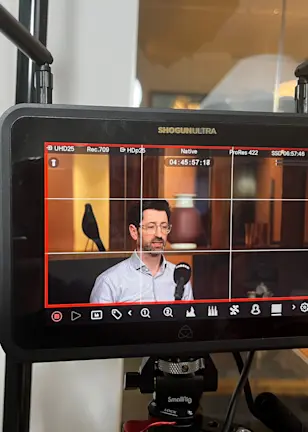Can you outline what you do in your role as Professor of Biodiversity Economics?
“I'm an environmental economist, working on the value of biodiversity in its various forms, through ecosystem services and its commercial values for things such as pharmaceuticals, the life sciences and agriculture. We try and put together a picture of where the economy is failing because the value of biodiversity is not taken into account. It's not priced in properly into any of the decisions that we make, such as what to eat, what clothes to wear, or where to go on holiday. We're not really taking into account the negative effects on biodiversity. We can evaluate the costs of supply and labor and transport and suchlike, but the cost for biodiversity is not included.”
“This also happens in the financial sector when we're thinking about moving capital from one place to another on the basis of the bottom line, making money for clients or improving our pension with whatever returns we can get. We don't account for the costs of land degradation, a loss of ecosystem services and biodiversity and so forth. It’s typically not reflected in those rates of return. And so the allocation of capital is skewed towards things which are overly harmful.”
“So, the economics of the story are very, very important. If you get the economics right, you can go a long way to solving the problems concerning biodiversity loss and degradation.”
Why isn’t biodiversity properly priced into things?
“Very often, biodiversity is invisible to us. When we are told about the degradation of ecosystem services in other countries through deforestation or whatever, we're not actually seeing that sort of thing happen. It's either a distant phenomenon, or more subtly invisible – such as the diversity of bacteria and fungi that are very important for maintaining soils and other ecological processes which provide economic benefits through things such as agriculture.”
“Being distant or invisible, these things don't really enter into our decisions or enter too late. So as an environmental economist, I work in an interdisciplinary way with other experts, with data and policy makers, trying to come up with solutions which involve assessing and correcting those failures in the in the market.”
“You get a lot of purchase with the public when one talks about extinction values, as people can typically conceptualize the idea, where the downside is the irreversibility of extinction. But it can be difficult to internalize what's going on at the frontier of tropical forests or marine degradation. So we need other signals to do that. This could be a price signal or a quantity signal or some other regulatory changes which change the nature of our decisions made by people, companies, investors and indeed governments.”
What policy initiatives are you involved with?
“At the moment I'm working with the UK Treasury on how to upgrade their guidance on cost/benefit analysis for public investment and public regulatory analysis, so that we explicitly take biodiversity into account, and value biodiversity when we make big investment decisions like HS2 (a new high-speed rail line), or regulatory decisions like banning pesticides. In the case of HS2, biodiversity enters in as a cost term, while in the banning of pesticides, it would come in as a benefit term – but a zero price is currently used for both.”
“And so again, it's the same story that investments are skewed towards things which ignore biodiversity. We're trying to update the guidance that the British Government uses in its ‘Green Book’ on cost/benefit analysis to reflect biodiversity more clearly. The good thing about that is the Green Book is seen as an international document, so many countries around the world use it for public investment appraisal, so it has broader reach and policy impact than solely in the UK.”
In your bio you say you specialize in ‘intergenerational fairness’? What is this?
“My work in this area comes from looking at the social discount rate for use in cost/benefit analysis. Loosely speaking, the social discount rate is like an interest rate, to discount back costs and benefits that happen to people in the future. The key problem in economic analysis is that many of the problems we have to deal with, like biodiversity and particularly climate change, have extremely long maturities for their costs and benefits to arise.”
“Investing in climate change mitigation now means the real benefits will be felt by people hundreds of years in the future. The global warming effect of the emission of one ton of carbon today will last for hundreds, if not thousands of years. So when you're doing the kind of raw investment and public investment analysis, the weight that you put on those benefits in the future is a really important signal as to whether or not you should go ahead with it. If you have 5% discount rate, for example, you really don't care about anything that happens beyond about 50 years.”
“So my work has been on the ethics of intergenerational discounting and how that should feed into government policy. We've been engaging with the Council of Economic Advisors and those involved in pricing carbon in the US, for instance. This involves essentially estimating an asset price for carbon by estimating its social cost, basically the present value of the stream of damages from emitting a ton of carbon today. The uncertainty and ethical aspects associated with it mean that you should probably be using a much lower discount rate than you would for financial or typical short horizon cost/benefit analysis. That's why my work can be thought of as dealing with intergenerational fairness, because it's about applying a discount rate over many generations.”
Don’t we really need to change consumer behavior? Aren’t we simply eating too much beef, for example, at great cost to the environment?
“This is a tricky area. Whereas diet is somewhere you can make a difference to your own footprint, the flipside is that it puts the initiative onto individuals. But your behavior doesn't guarantee other people's behavior; if you consume less of something, somebody else might consume more of it. What’s really required is an overarching framework that we're all working under. In terms of individual behavior, the key is to vote for political parties that stand up for those particular things, or to support movements protecting the environment.”
“With carbon, the key technology change concerns energy; with biodiversity, it is likely to be in agriculture and the food system. Meat for example is hugely underpriced compared to the environmental damage it does, and reducing its consumption is going to be important for the solution. But we also need to have movements and policies in place to make sure that things really happen across the board for all activities.”
獲取最新市場觀點
訂閱我們的電子報,時刻把握投資資訊和專家分析。
Can we continue using the capitalist system to protect biodiversity, such as the investment opportunities present in commercial projects such as reforestation?
“Money is an important driver. As an environmental economist working in the public sector, I see we have a tendency to lean on the idea of regulation driving everything, from the pricing of externalities to the setting of standards to restrictions on quantities and trade. But we are in an economic system, with all the associated incentives. The flaw being that it doesn’t account for much of what we value in society, either today or for future generations, such as biodiversity.”
“As it stands, these problems will not be solved unless it is worthwhile financially for decision makers, irrespective of the clear economic arguments. There are lots of opportunities in biodiversity, just as there are in carbon. Only with the latter, it's much clearer what what's going to make a reasonable investment and what the projects are: reforming the energy system and solving the climate problem. Regulation and international agreements have enabled this to a great extent.”
“With biodiversity, it's a lot trickier. It's clear that nature provides huge economic and other values. We see nature-based solutions and examples of internal markets within countries and payments or ecosystem services where you can pay people upstream to maintain forests so that the water quality downstream is better. In some cases, you don't necessarily need any regulation but in most you do.”
“So I think there are huge opportunities for that, and opportunities for regulation. Once you start saying, look, we need to have a biodiversity net gain in this country, and anything you do as an entity has to subscribe to that, then this can foster a market in protecting biodiversity where the response is that there's money to be made in solving these problems. Ultimately, the incentives have to be there, otherwise it's just not going to get solved.”
Do you think the Kunming and Montreal conferences were a success, or just more talking without doing?
“I was pleasantly surprised by the progress that was made in Kunming. They managed to settle on the 30 by 30 (putting 30% of the planet and 30% of degraded ecosystems under protection by 2030) which was a pivotal moment. Shoring up previous agreements on benefit sharing for biodiversity and genetic material, and also ensuring that there's finance for developing countries, are great, but a concrete target was never there before. So that was a big step, the biodiversity equivalent of the Paris Agreement.”
“The question is how it's implemented now. It's easy to set up a protected area in places that were never going to be threatened, or have a low biodiversity value. The real issue is how to implement this in the way that provides the biggest biodiversity hit, because protecting an area doesn't mean necessarily mean adding large amounts of biodiversity.”
What about the reliability of biodiversity data and locational analysis? Aren’t there still real problems with trying to get good data?
“It’s a difficult issue but we’re slowly overcoming it. It’s essentially a supply chain story and trying to understand either through corporate disclosures or generalized impact analysis the impact particular companies are having. Projects out there have specific data, but nowhere near good enough. Very often the locational data is about headquarters and peripheral parts, which are not necessarily at the coal face.”
“Locational data matched with biodiversity impact-type data is ideal, but the latter is typically very sketchy and imprecise. And then what will you do with that data? How will you solve the initial problem? But there's sufficient interest in the financial sector in terms of ensuring disclosure of biodiversity impacts, certainly with regard to the EU Taxonomy, initiatives like the TNFD, and the broader CSR type incentives to do this. Even in the past two years, things have improved on that front. So I don't see this as a ‘we shouldn't do this because the data is terrible’ issue. I think the sector is moving in the right direction.”
What about doing more to prosecute illegal activity? Much of the deforestation in Brazil, for example, is through illegal logging.
“Viewing biodiversity loss as a crime, or using sanctions against countries, is a very tricky thing. If you look at Brazil, 60% of the consumption of soy and meat produced there is domestic. So the international trade side of things or threatening sanctions is less effective than you might think, in that it's not going to solve everything. Biodiversity laws already exist in many countries – it's really about the enforcement capabilities within them. But the incentives to do that are very, very low. If you go up against a logging company in Brazil and try and enforce the law, you do so at very high financial and often personal risk.”
“Many livelihoods also rely on cutting down forests. This is how many countries have reduced poverty, for instance. The key is to work on incentives within the country at that margin and make it more viable for standing forest to remain rather than forests being cut down. Rural urban migration may take the pressure off the forest frontier to some extent, but this only happens when there are other opportunities in urban areas.”
“The incentives for agricultural business and logging companies are very different and changing incentives here is difficult. We should look at the demand side for agricultural and forest-related products, both locally and via international trade, and the accompanying incentives regulations. We also need to think about the transfer of resources to tropical countries to maintain forests that provide global public goods, like biodiversity and carbon storage.”
Finally, what should investors do (or not do) to help protect biodiversity?
“You should be making a virtue out of avoiding companies that openly harm biodiversity and strongly engage with those that can improve by making their activities more sustainable. That should become more important for investors over time, particularly as regulation on sustainability and biodiversity tightens.”
“The other thing is you should be getting out of fossil fuels, which is happening anyway over time. Something similar needs to happen with very resource-dependent industries as well. If I were an asset manager, I would be seriously considering moving away from anything involving tropical deforestation or again making major efforts to engage and change practices.”
Important information
The contents of this document have not been reviewed by the Securities and Futures Commission ("SFC") in Hong Kong. If you are in any doubt about any of the contents of this document, you should obtain independent professional advice. This document has been distributed by Robeco Hong Kong Limited (‘Robeco’). Robeco is regulated by the SFC in Hong Kong. This document has been prepared on a confidential basis solely for the recipient and is for information purposes only. Any reproduction or distribution of this documentation, in whole or in part, or the disclosure of its contents, without the prior written consent of Robeco, is prohibited. By accepting this documentation, the recipient agrees to the foregoing This document is intended to provide the reader with information on Robeco’s specific capabilities, but does not constitute a recommendation to buy or sell certain securities or investment products. Investment decisions should only be based on the relevant prospectus and on thorough financial, fiscal and legal advice. Please refer to the relevant offering documents for details including the risk factors before making any investment decisions. The contents of this document are based upon sources of information believed to be reliable. This document is not intended for distribution to or use by any person or entity in any jurisdiction or country where such distribution or use would be contrary to local law or regulation. Investment Involves risks. Historical returns are provided for illustrative purposes only and do not necessarily reflect Robeco’s expectations for the future. The value of your investments may fluctuate. Past performance is no indication of current or future performance.


















